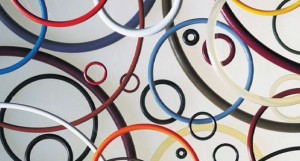
They can also be made from a number of different substances. Here’s a guide to the kinds of O-Ring materials we use, how they are used, and when to avoid using them.
Nitrile (Buna, NBR): A widely used, economical material that has strong wear resistance and mechanical properties.
- Temperature: -55 to 250 degrees Fahrenheit
- Applications: Petroleum based oils and fuels, dynamic applications
- Avoid: Brake fluids and ozone
Hydrogenated Nitrile (HNBR): Nitrile base with added chemical strength and resistance following hydrogenation.
- Temperature: -50 to 300 degrees Fahrenheit
- Applications: Water and steam up to 300 degrees Fahrenheit, fuel systems, oil resistant and high abrasion applications
- Avoid: Strong acids and polar solvents such as ethers and ketones
Polyacrylate (ACM): Widely used by auto makers in power steering and transmission systems.
- Temperature: -15 to 350 degrees Fahrenheit
- Applications: Mineral oil, engines, gear boxes, power steering, transmissions
- Avoid: Cold temperatures, hot water, steam
Ethylene-Propylene (EPDM): Strong ozone and chemical resistance
- Temperature: -55 to 275 degrees Fahrenheit, 300 degrees Fahrenheit when used with peroxide curing agents
- Applications: Brake systems, glycol-based fluids, H20 steam
- Avoid: Mineral oil products and hydrocarbon fluids
Chloroprene (Neoprene, CR): The first commercial synthetic rubber developed, chloroprene has good mechanical properties over a wide range of temperatures.
- Temperature: -40 to 250 degrees Fahrenheit
- Applications: Refrigeration, due to its excellent ozone resistance, low-temp H20
- Avoid: Esters, ketones and aromatic and chlorinated hydrocarbons.
Butyl: An all-petroleum compound, butyl has low gas permeability and good resistance to sun exposure and ozone.
- Temperature: -70 to 400 degrees Fahrenheit
- Applications: Life science and medical devices, FDA applications, numerous specialized compounds for specific material certifications
- Avoid: Highly abrasive applications and water and steam over 250 degrees Fahrenheit
Fluorosilicone (FVMQ): Broad temperature performance and strong fuel and solvent resistance, but weak abrasion resistance due to high friction.
- Temperature: -75 to 400 degrees Fahrenheit
- Applications: Aerospace, fuel and mineral oil
- Avoid: High temperature air, dynamic applications
Fluorocarbon (Viton, FKM): The high fluorine levels in fluorocarbon rings give them excellent swelling and permeability resistance. They also feature high temperature and chemical resistance.
- Temperature: -15 to 400 degrees Fahrenheit
- Applications: Broad chemical resistance, transmission and blended gasoline
- Avoid: Low temperatures, ketones and amines
Tetrafluoroethylene-Propylene (AFLAS): Excellent chemical and temperature performance.
- Temperature: 15 to 450 degrees Fahrenheit
- Applications: Aerospace, steam, hot water, oil fields
- Avoid: Chlorinated hydrocarbons, ketones, acetic acid
Perfluoelastomer (FFKM): Of all elastomers, this one has the highest performing temperature and chemical properties, as well as low out-gassing and extractable properties.
- Temperature: -15 to 600 degrees Fahrenheit
- Applications: Semiconductors, chemical processing, vacuum applications
- Avoid: Fluorinated solvents and perfluorinated lubricants
If you have questions about O-Ring materials, contact Gallagher Fluid Seals, Inc. Our experts can answer any questions you might have about these small, yet crucial, sealing products.
You can also learn more about O-Rings by downloading this guide, which discusses their technical performance characteristics, materials, chemical and temperature compatibility, hardware considerations and failure modes.
